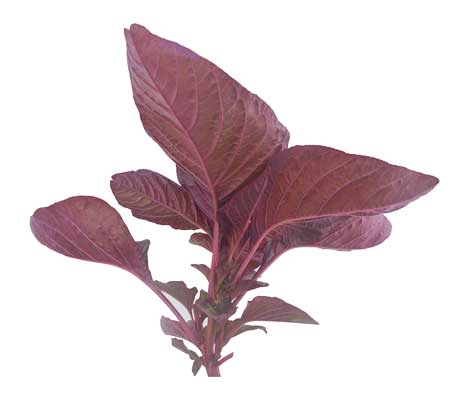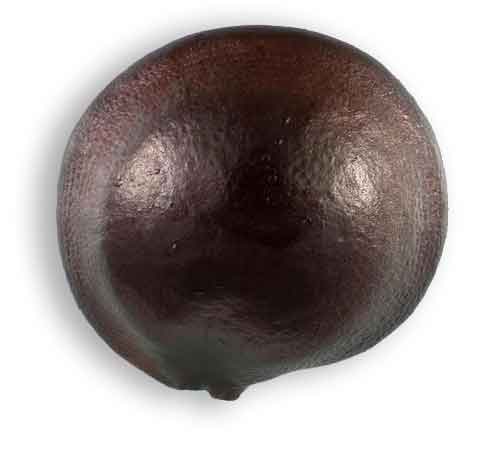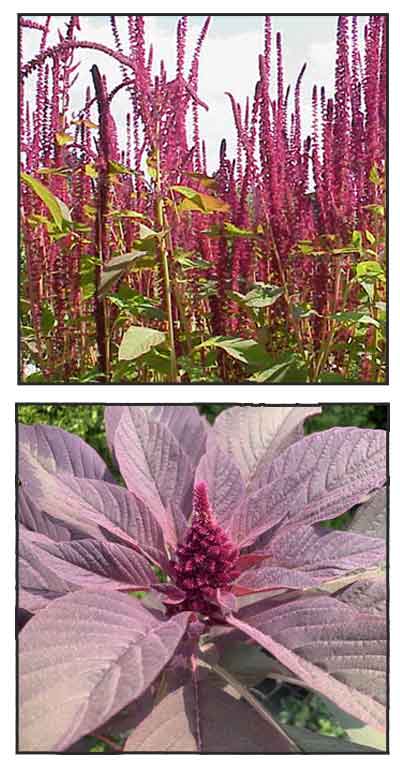
Gen info
- Amaranthaceae is a family of flowering plants commonly known as the amaranth family, in reference to its type genus Amaranthus.
- Amaranthus is a cosmopolitan group of more than 50 species making up the genus of annual or short-lived perennial plants collectively known as amaranths.
- Among systematists, Amaranthus has been generally
considered a "difficult" genus and to hybridize often. (25)
- Etymology: The genus name Amaranthus derives from Ancient Greek words: amarantos, meaning "immortal"; a- romanized "without", and maraino, meaning "to consume, to exhaust", referring to the amaranth;s reputation for not withering - in particular, its calice, which remains persistent, thus representing a symbol of immortality. (25) Alternatively, the genus name Amaranthus derives from Greek words for unfading flower, amarantos and anthos. (27)
-
Amaranth is one of the many little known, underexploited crops which shows potential as a global source of nutritious grains and a tasty leafy vegetable. In fact, Amaranthus cruentus is one of the oldest known food crops. The earliest archaeological record of pale seed grain Amaranth is that of A. cruentus found in Tehuacan pueblo in Mexico, about 4000 B.C. (22)
 Botany Botany
• Halon is an erect, stout, branched, unarmed, annual herb, growing to a height of 1 to 2 meters. All parts are usually reddish-purple. Lower leaves are oblong-ovate to ovate-lanceolate, up to 25 centimeters long, 8 centimeters wide, with long petioles. Upper leaves are similar in shape but smaller. Panicled inflorescences are terminal and are borne in the upper axils of the leaves. Panicles are 15 to 30 centimeters long, red, green or yellow. Flowers are numerous, about 1.5 centimeters long. Sepals are oblong to oblong-obovate, apiculate and shorter than the bracts. Utricle is 3-toothed at the apex, circumciss, exceeding the calyx. Seeds are brown or black, shining, about 1 millimeter in diameter.
Distribution
- Introduced.
- Naturalized.
-
In open waste places, at low and medium altitudes, from northern Luzon to Mindanao.
- Cultivated as a grain crop in some countries.
- Native to El Salvador, Guatemala, Honduras, Mexico Central, Mexico Gulf, Mexico Southeast, Mexico Southwest, Nicaragua. (24)
Constituents
- Contains a high content of beta-carotene, ascorbic acid and folate.
- Oil from Amaranthus cruentus contain 19% palmitic acid, 3.4% stearic acid, 34% oleic acid, 33% linoleic acid, 9% docosaenoic acid.
- Crude protein of grain amaranth ranges from 12.5 to 17.6 % dry matter, higher than most grains except for soybeans. The protein yields around 5% lysine and 4.4% sulfure amino acids. Total lipid content ranges from 5.4 to 17.0 % dry matter with about 75% unsaturation, containing about 50% linoleic acid. Â (14)
- Proximate analysis of A. cruentus are moisture 6.23 - 6.71%, crude protein 13.2-17.6 % (dmNx6.25), total lipids 6.3-8.1, crude fiber 3.4-5.3, crude ash 2.8-3.6, Na 31.0 mg (mg/100gDM), K 290 mg, Ca 175 mg, Mg 244 mg, Fe 17.4 mg, Zn 3.7 mg, Cu 1.2 mg, Mn 4.6 mg, riboflavin 0.19-0.23 mg, niacin 1.17-1.45 mg, ascorbic acid 4.5 mg, thiamin 0.07-0.1 mg, phytate (%) 0.50-0.58 mg, tannin (catechin equiv %) 0.043-0.13 mg. (14)
 Properties Properties
- Nutritionally, leaves are an excellent source of protein. Plant is a good source of minerals, such as iron, calcium, phosphorus and carotenoids.
- Studies have shown antioxidant, chemopreventive, radioprotective, phytoremediative, anthelmintic, gastroprotective, hypolipidemic, hepatorenal protective, antidiabetic, antihypertensive, antianemic, HMG-CoA-reductase inhibitory properties.
Parts used
Leaves, seeds.
 Uses Uses
Edibility / Culinary / Nutrition
- Seeds eaten as cereal grain; ground into flour, popped like popcorn, or cooked into porridge, or made into a confectionery called alegria. (26)
-
In Iran and Iraq, seeds and tender leaves are eaten.
- Leaves are usually cooked; eaten as stand-alone vegetable dish or as salad. Leaves can be dried and ground into a powder and used in sauce preparations.
- Leaves considered an excellent source of protein.
- In France, leaves are used like spinach.
- In Southeast Asia, plant is used as a vegetable.
- In Nepal, dried seeds and ground into flour and eaten as gruel.
- In Chhattisgarh, red amaranth is used to make Lal Bhaji, a stir-fried dish. In Maharashtra, during the month of Shravan, it is a festival dish served as vegetable with just grated coconut. (26)
- Among the Zuni people, the feathery part of the plant is ground into a fine meal and used to color ceremonial bread red. (26)
Folkloric
- Decoction of leaves used for chest afflictions
- In traditional and folk medicine, used for respiratory infections, vision defects, tuberculosis, fleshy tumors, liver problems and inflammations.
- In Ayurveda, leaf decoction used for chest afflictions and gastroenteritis; seeds applied to sores.
. Seeds and leaves use as astringent for stopping diarrhea, bloody stools, hematuria, and excessive menstruation. (10)
- In India, seeds are used as food and medicinally, as diuretic.
- Also, applied to scrofulous sores.
- Roots, boiled with honey, used as laxative for infants. Water extract used as tape worm expellant and for wound cleansing. (19)
- In Pakistan, cooked leaves are eaten as laxative. (30)
Others
- Dye: Whole plant yields a dye. Flowers used as food coloring.
- Cosmetic: The crushed leaves and blossoms are moistened and rubbed on the cheeks as rouge. (26)
Studies
• Radiomodulatory / Gamma Irradiation: In pretreated irradiated animals the level of GSH was significantly higher but LPO level decreased significantly. Study showed albino mice pretreated with leaf extract provided protection against gamma irradiation in mice. (1)
• Antioxidant and Radioprotection: Study showed mice pretreated with Amaranthus extract was protected against various biochemical changes. Results support the postulate that increased ROS induced by radiation exposure may be involved in some of the aversive effects of stress. Antioxidants in the extract are able to cope with radiation-induced oxidative stress to some extent, and may be due to the synergistic effects of some herb constituents. (3) Study showed Amaranth supplementation provides antioxidative efficacy and benefits in learning performance after ionizing radiation exposure to the brain.
• Radioprotective / Antioxidant Constituents: Methanolic extract of A. paniculatus increased survivability in Swiss albino mice against lethal dose of gamma radiation. Radiation induced augmentation in MDA, protein, and glycogen content of liver is significantly ameliorated by amaranth extract, and radiation-induced depletion in glutathione and cholesterol is checked by treatment with AE. Protection may be attributed to synergistic effects of constituents rather than a single factor, as all constituents are well known antioxidants. (8)
• Antioxidant: (1) The ability of A. paniculatus extract to act as a free radical scavenger or hydrogen donor was revealed by DPPH radical-scavenging activity assay. (2) Amaranth seeds, in a dose-dependent manner, can act as a moderate protective agent against fructose-induced changes in rats by reducing lipid peroxidation and by enhancing the antioxidant capacity.
• Saponins / Toxicity Study / Safety: Study concludes that the low content of saponins in amaranth seeds and their relatively low toxicity guarantee that amaranth-derived products create no significant hazard for the consumer.
• Antioxidant / Chemopreventive Potential: Study investigated the antioxidant capacity and possible protective effect of leaves on the antioxidant defense system in Erhlich's ascites carcinoma-treated mice. The leaf extract showed significant reduction in tumor volume, viable cell count, tumor weight, and increase life span of EAC-bearing mice. There was also improved antioxidant potential. Results suggest significant protection against oxidative stress conditions and a chemopreventive potential that can be exploited for antitumor agents. (10)
• Radioprotective / Leaves / Gamma Radiation: In a study that investigated the radioprotective effect of an aqueous extract of leaves against gamma radiation in Swiss albino mice, results showed a modulation of radiation-induced decrease of reduced glutathione and the radiation-induced increase in lipid peroxidation in the liver and blood. (11)
• Anaphylaxis Report from Rajgira Seed Flour: Clinical and immunological investigation on anaphylaxis after consuming Rajgira seed flour revealed SPT (skin prick tests) and oral challenge positivity beside high allergen specific IgE in the serum of the patient. Three IgE binding protein fractions were detect in roasted flour extract which were considered allergenically important for triggering anaphylaxis. (12)
• Nutritional and Functional Properties as Infant Complementary Food: Study evaluated the nutritional and functional properties of A. cruentus grain grown in Kenya for preparation of a ready-to-eat product that can be recommended as infant complementary food. Processing amaranth grain did not significantly affect its nutritional and physiochemical properties. Amaranth grain was rich in protein, with good amounts of important minerals. Reconstituting the product with milk can enrich the deficient nutrients. The product would also be appropriate for use in geriatrics and immuno-compromised individuals. (15)
• Phytoremediation: Study evaluated the potential of A. cruentus as a soil lead remediating plant. Results showed EDTA has some effect on lead solubility in soil as well as lead absorption by A. cruentus. Lead contamination did not have significant effect on growth and yield parameters of A. cruentus. Since the transfer factor (TF) is greater than one, AC may be a promising species for phytoremediation. (16)
• Seeds and Products / Source of Bioactive Compounds: New products have been produced from seeds including expanded "popping" seeds and flakes. Study evaluated the susceptibility of biologically active products due to processing. Study showed protein, fat, and starch content did not change during seed processing. However, total tocopherol content of 10.6 mg/100 g seeds was reduced by about 35% in "popping" and flakes. Squalene content ranged from 469.96 mg/100g for seeds to 358.9 mg/100 g flakes. No differences were observed in fatty acid profile of seeds and products, while differences were noted in the sterol content. (17)
• Anthelmintic: Study evaluated various extracts for anthelmintic activity against adult Indian earthworm Eicinia feotida. An aqueous extract showed significant wormicidal activity against earthworms. The extract was found to be more potent than standard albendazole. (19)
• Bioactive Compounds in Seeds and Products: New products from amaranth seeds, including "popping" seeds and flakes, have entered the food market. Study evaluated the protein, fat, starch, and ash content, fatty acids, sterols, tocopherols and squalene content. Protein, fat, and starch content did not change during seed processing. However, the tocopherol content of seeds (10.6 mg/100g) was reduced by approximately 35% in "popping" and flakes products. Squalene content ranged from 469.96 mg/100 g of seeds to 358.9 mg/100 g flakes. (20)
• Toxicity Study on Seed Saponins: The total concentration of saponins in seeds was 0.09-0.1% of dry matter. Study concludes that low contents of saponins in amaranth seeds and their relatively low toxicity guarantee that amaranth-derived products present no significant hazard for the consumer. (21)
• Gastroprotective / Pectin: Study evaluated the gastroprotective effect of amaranth pectin from Amaranthus cruentus in indomethacin and meloxicam nonsteroidal anti-inflammatory drugs (NSAID)-induced stomach lesions in male Wistar rats. Results showed oral administration of amaranth pectin enhanced the resistance of stomach tissue to NSAIDs with a gastroprotective effect as evidenced by decrease in number and sizes of destructive lesions, reduction of ATP and glycogen deficiency. decrease in excess lactate and normalization of energy balance in gastric tissue. (23)
• Hypocholesterolemic: Study on the function of specific A. cruentus proteins suggest the plant has hypocholesterolemic properties.Three-hydroxy-3-methylglutaryl-CoA reductase is the crucial enzyme involved. The substantial squalene concentration of amaranth oil is linked to the hypolipidemic action. A previous study suggested the benefit of dietary supplementation to ward against diabetic retinopathy may be from the fluid extract of heated red amaranth foliage. (28)
• Protective Against Lead-Induced Hepatorenal Toxicity / Leaves: Study evaluated the protective effects of A. cruentus hydroethanolic leaf extract (HE) against lead-induced hepatorenal toxicity in rats. Toxicity was induced through intraperitoneal injection at 25 mg/kbw. Doses of oral treatment varied with 100, 250, and 500 mg/kbw. Phytochemical analysis revealed rich presence of phenols, flavonoids, saponins, tannins, coumarins, cardiac glycosides, and steroids. Results showed the HE leaf extract could significantly mitigate lead-induced hepatorenal toxicity in rats, evidenced by restoration of biochemical, hematological, and histopathological parameters. Study suggests a promising treatment alternative with minimal to no side effects. (29)
• Antidiabetic / Antihypertensive / Leaf and Inflorescence: Study evaluated the potential of A. cruentus aqueous and methanol extract from leaves and inflorescences and phytoconstituents as antioxidant, antidiabetic, and antihypertensive agents. Results showed significant pharmacological and therapeutic potential, particularly in diabetes management. Effects are attributed to the ability to inhibit   α-amylase and α-glucosidase involved in the hydrolysis of complex carbohydrates, and their antioxidant action and capacity to inhibit the angiotensin-converting enzyme (ACE). (30)
• Inhibition of HMG-CoA Reductase Activity / Peptides: Study sought to identify the major peptides generated by in vitro hydrolysis of A. cruentus protein and to verify the effect of the peptides on the activity of HMG-CoA reductase, the key enzyme in cholesterol biosynthesis. Three major peptides under 3 kDa were detected, corresponding to more than 90% of the peptides of similar size produced by enzymatic hydrolysis. Study found the sequences of GGV, IVG, and VGVL significantly inhibited HMG-CoA reductase, suggesting possible hypocholesterolemic effect. (31)
• Ergogenic Potential / Dietary Sports Nutrition Supplement: Amaranthus is considered a superfood with high nutraceutical value. Study presents a comprehensive overview of the ergogenic potential of Amaranthus and insights into developing Amaranthus-based dietary supplements for enhancing sports performance. (32)
• Antianemic in Phenylhydrazine-Induced Anemia: Study evaluated the antianemic properties of Amaranthus cruentus in a phenylhydrazine-induced rat model of anemia. Results showed Amaranthus cruentus extract significantly improved RBC count, Hb levels, and HCT values, suggesting potential for mitigation of oxidative stress-induced hemolysis. Rich phytochemical profile, including flavonoids, tannins, and phenolic compounds, probably contributes to the antioxidant activity and efficacy against anemia. Results suggest potential as natural remedy for anemia. (33)
Availability
- Wild-crafted.
- Seeds and supplements in the cybermarket.
|

![]()




 Botany
Botany
 Uses
Uses